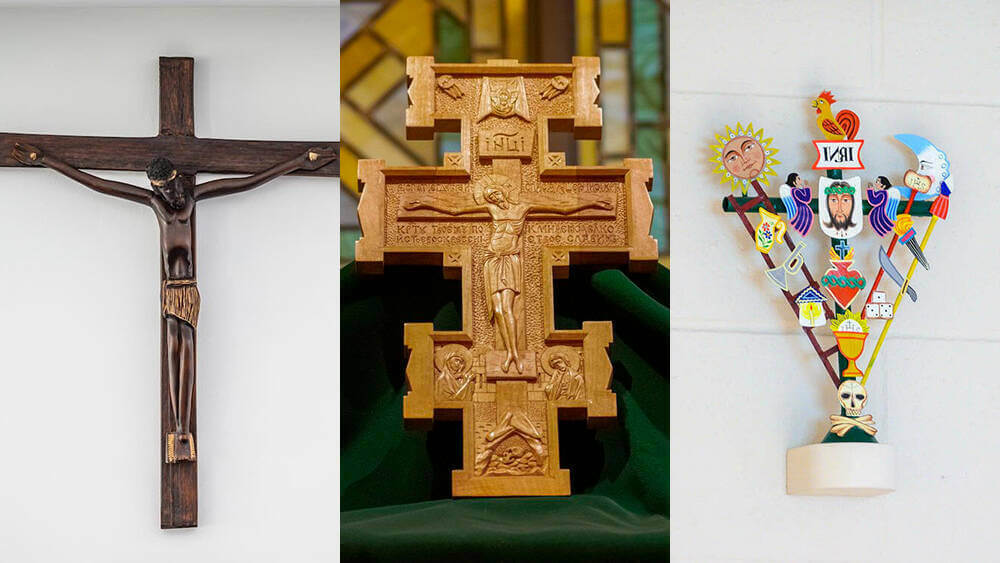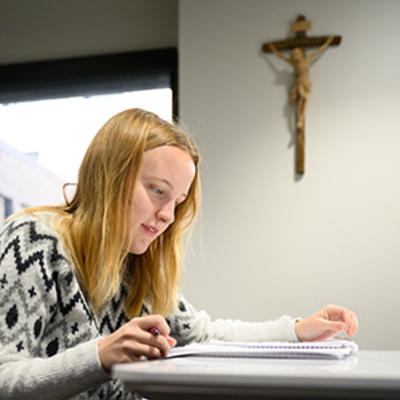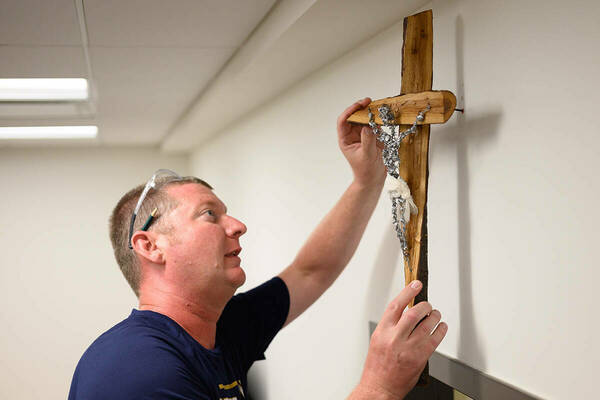Global works of art from Notre Dame Crucifix Initiative to be displayed at The History Museum

The image of the crucifix in sacred art holds the ability to convey both the humanity and divinity — the beauty and the suffering — of Christ.
For Mark Roche, founder of the University of Notre Dame’s Crucifix Initiative, it also represents the universalism and diversity of the Catholic experience.
Launched in 2019, the initiative seeks to highlight the globalism of Catholicism — and to represent the diversity and internationalism of the University and its community — by building and displaying a collection of crucifixes from around the world.
Selected works of art from the Crucifix Initiative will be on view in an exhibit starting Thursday (Aug. 10) at The History Museum in South Bend, Indiana. Developed by Notre Dame International, the exhibit chronicles the history of international education at the University of Notre Dame, from its founding to today, with attention to the theme “Bringing the world to Notre Dame and Notre Dame to the world.”

To date, the Crucifix Initiative’s growing collection, displayed in classrooms and buildings across campus, includes nearly 40 representations of the crucifix from six continents and more than 20 countries.
As more and more students from around the world and from diverse American backgrounds come to Notre Dame, University leaders continue to look for additional ways to foster a welcoming environment, said Roche, the Rev. Edmund P. Joyce, C.S.C., Professor of German Language and Literature and a concurrent professor of philosophy. Displaying these works of art not only contributes to that environment but also offers an opportunity for reciprocal learning, he said.
“The diversity of styles and emphases that we find in crucifixes from around the world are extraordinary,” said Roche, a former dean of Notre Dame’s College of Arts and Letters and chair of the committee leading the Crucifix Initiative. “We want to cultivate and embrace that diversity here on campus and, through these connections, express our solidarity with artists and regions around the world.”
Not only are the crucifixes wide-ranging, the initiative to bring crucifixes to Notre Dame involves one of the broadest-based committees at the University, bringing together the expertise and capacities of faculty, staff, students and members of the Congregation of Holy Cross.
Representations of the crucifix on display at The History Museum will include:
- A brightly colored “Road Cross” from Huancayo, Peru, designed to protect travelers on their journeys, adorned with symbols including a rooster, a ladder, the sun and the moon, along with the face of Christ.
- A simple and slender wooden crucifix, crafted by local artists in the port city of Luanda, Angola, and bringing together Central African and European artistic genres.
-
A contemporary Chinese painting, “Crucifixion on the Red Cross,” donated by renowned artist Dao Zi and featuring bold colors, sweeping lines and exaggerated proportions of the holy nails.
-
A detailed pearwood carving titled “Life-Giving Cross” with images of Mary and John alongside Jesus that follows the Ukrainian Greek Catholic tradition of Fr. Yuvenaly Mokrytsky, a hieromonk whose religious order was brutally suppressed by the Soviet Union.

The initiative is working to secure additional works of art with support from Notre Dame faculty, staff, students and alumni clubs worldwide. Its most recent acquisitions include a Japanese crucifix in the style of a butsudan — a small wooden box with cabinet doors that enclosed a painting or statue of Buddha — commonly used by underground Catholics at a time when Catholicism was suppressed, and a forthcoming piece from Ireland made from a bog oak tree that has been carbon-dated to 5,600 years ago. The committee is also working with First Nations artists on several pieces.
A contest will also be announced at the beginning of the academic year for a student-designed and -crafted crucifix to be added to the collection, and plans are underway for a self-guided tour of the crucifixes on campus during the Lenten season.
The initiative, Roche said, helps to further Notre Dame’s Catholic mission, as well as the University’s goals of prioritizing diversity and inclusion, elevating the arts and promoting student research and creative work.
“The arts are central to a Catholic university,” Roche said. “In the history of the arts to the early modern period, every artwork was created for the greater glory of God, and the sacramental vision of Catholicism is the idea that the divine is made visible, manifest in this world. There is a special connection between images of the crucifix, in particular, and both the universalism and diversity of the Catholic experience worldwide.”
Latest International
- Using forest resources strengthens food security, study findsForests can reduce hunger in rural households while also capturing carbon and advancing sustainability goals for low- and middle-income countries, according to new research by Daniel C. Miller, associate professor of environmental policy at Notre Dame’s Keough School of Global Affairs.
- Notre Dame Global names Eimear Clowry Delaney as director of Notre Dame DublinEimear Clowry Delaney has been appointed the Michael J. Smurfit Director of Notre Dame Dublin and officially assumed the role on July 1. Kevin Whelan, who has served as the inaugural director since 1998, will now shift his focus to teaching and research.
- COVID-19 pandemic tied to low birth weight for infants in India, study showsThe incidence of low birth weight rose sharply in India amid the COVID-19 pandemic, according to new research from Santosh Kumar, associate professor of development and global health economics at Notre Dame’s Keough School of Global Affairs.
- Peace Accords Matrix expands to the PhilippinesBuilding on its international success and reputation in peace accords monitoring, the Kroc Institute for International Peace Studies, part of the Keough School of Global Affairs, and its Peace Accords Matrix (PAM) program have launched their next global project: PAM Mindanao (PAM-M) in the Philippines.
- US states shape foreign policy amid national China unease, research showsState-level officials such as governors, state legislators and attorneys general are shaping U.S.-China relations as the two countries navigate a strained geopolitical relationship, according to new research by Notre Dame political scientist Kyle Jaros.
- Rigorous new study debunks misconceptions about anemia, educationIn low- and middle-income countries, anemia reduction efforts are often touted as a way to improve educational outcomes and reduce poverty. A new study, co-authored by a Notre Dame global health economics expert, evaluates the relationship between anemia and school attendance in India, debunking earlier research that could have misguided policy interventions.













